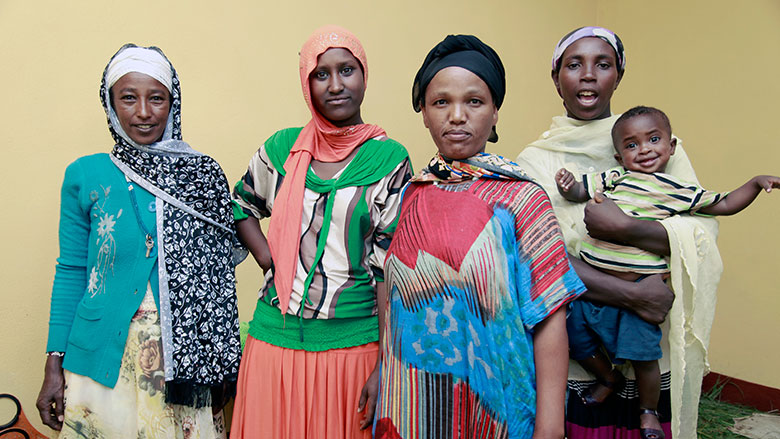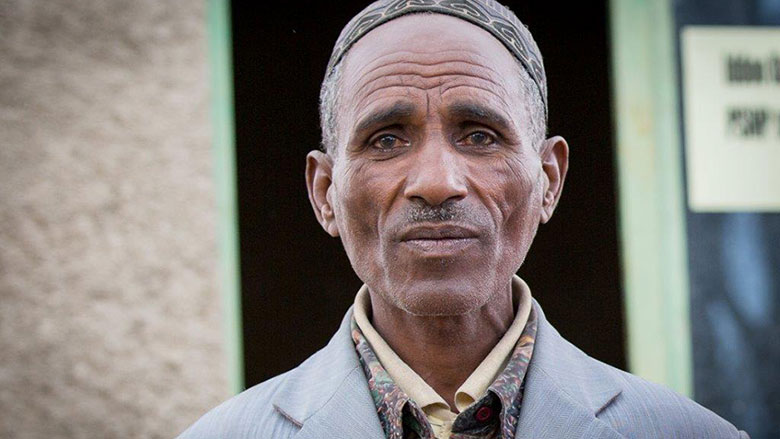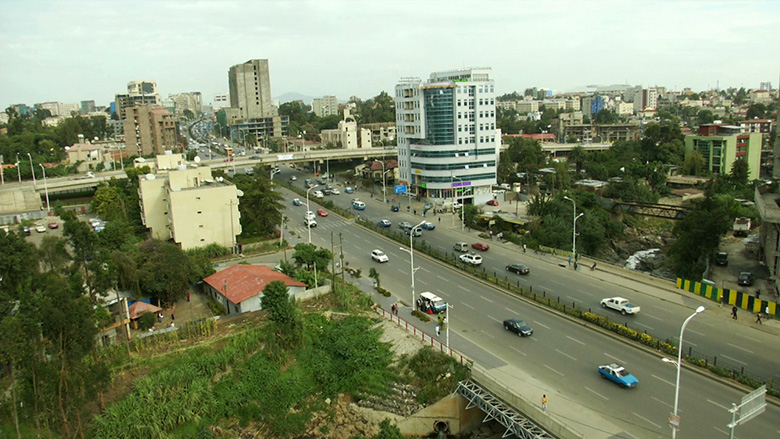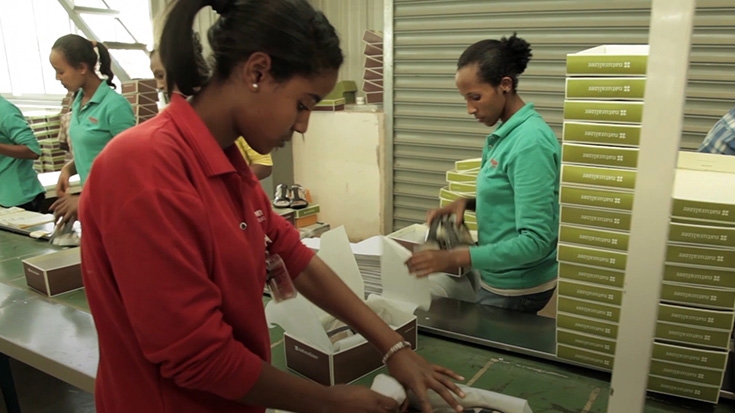Challenge
Despite the progress, Ethiopia’s poverty challenges remain deep-rooted and require sustained efforts. Ethiopia has achieved the Millennium Development Goals (MDGs) for child mortality and water. There has also been encouraging progress particularly in gender parity in primary education, HIV/AIDS, and malaria. Positive results have also been achieved in universal primary education. Ethiopia is now strategically planning for the Sustainable Development Goals. Notwithstanding the progress in critical aspects of human development, Ethiopia needs considerable investment and improved policies to reach its development objectives, given the country’s low starting point.
Approach
The World Bank Group’s (WBG) Country Partnership Strategy (CPS) FY13-FY16 is helping help the government address ongoing challenges and assisting in the implementation of Ethiopia’s Growth and Transformation Plan (GTP) which is currently in its second phase.
The CPS framework includes two pillars with governance as foundation and two cross cutting themes. Pillar One, ‘Fostering competitiveness and employment’, aims to support Ethiopia in achieving a stable macroeconomic environment; increasing competitiveness and productivity; improving delivery of infrastructure; and enhancing regional integration. Pillar two, ‘Enhancing resilience and reducing vulnerabilities’ is geared towards improving the delivery of social services and developing a comprehensive approach to social protection and risk management. Good governance and state building form the foundation of the CPS. In line with the GTP, gender and climate change are cross-cutting issues in the CPS.
Results
The International Development Association (IDA) has been supporting Ethiopia’s efforts to improving the quality and delivery of equitable access to vital services in health, education, water and sanitation, agriculture and roads, for the poorest.
With support from IDA credits and grants, the Government of Ethiopia has made important strides on a number of core sector indicators. Here are selected results.
- Net primary enrollment went from 77.5% in 2006 to 92.6%2015.
- The ratio of girls to boys for grades 5-8 increased from 88% in 2007 to 97% in 2014.
- The proportion of teachers with a diploma increased from 3.4% to 70% for Grades 1-4, and from 53% to 92% for Grades 5-8 between 2006 and 2015.
- Child mortality dropped from 72 to 31 between 2005 and 2015.
- Access to modern contraceptives rose from 14% to 40% between 2005 and 2015.
- Access to improved sanitation increased from 38% to 66% between 2005 and 2015.
- Access to agriculture extension services rose from 4 million to 13 million during the last decade.
- The road network increased from under 20,000 km in 1991 to over 100,000km in 2015
Bank Group Contribution
IDA is Ethiopia’s largest provider of official development assistance. As of March 2016, the Bank has commitment close to $7.5 billion. This includes $6.4 billion from IDA for 25 projects and $1.1 billion for 102 trust funds. IFC portfolio consists of seven projects with outstanding commitment of nearly $190 million. Multilateral Investment Guarantee Agency (MIGA) support consists of four investments totaling $18 million. The World Bank Group has also introduced programmatic knowledge services in key areas such as economic policy, poverty, gender and statistics, public sector and governance, and protecting the services for the bottom 40%. The International Finance Corporation (IFC) and IDA have collaborated on a number of these activities including on the competitiveness agenda. Currently, the Ethiopia portfolio has 28 active Advisory Services and Analytical Activities (ASA).
Partners
The Development Assistance Group (DAG), which comprises of 27 bilateral and multilateral development agencies, is the main forum for donor coordination in Ethiopia. The DAG aims to ensure more effective delivery and utilization of development assistance to Ethiopia. The DAG works within the frameworks of global declarations and action plans such as the Rome (2003) and Paris (2005) Declarations, the Accra Agenda for Action (2008) and the Busan Partnership for Effective Development Co-operation (2011).
The WBG, with the United Nations and one bilateral donor, served as rotating co-chairs of the DAG. The WBG has taken the lead in developing a set of multi-donor instruments and programs to reduce transaction costs, align support with the country’s decentralized model, and enhance the predictability of aid. Several IDA projects in the Ethiopia portfolio are co-financed with other donors, including the two largest IDA programs—the Promoting Basic Services Program and the Productive Safety Nets program. Projects with large-scale leveraging of IDA support are: the Agricultural Growth Program II, Enhancing Shared Prosperity through Equitable Services, General Education Quality Improvement Project II, Water supply, Sanitation and Hygiene project and the Women Entrepreneurship Development. The WBG also leads the production of key analytical work/ knowledge products which DAG members rely on to guide their programs and policies.
Moving Forward
IDA will continue to support the government in achieving a stable macroeconomic environment; increasing agricultural productivity and marketing in selected areas; increasing competitiveness in manufacturing and services, and Medium and Small Enterprises’ access to financial services; improving access to and quality of infrastructure – electricity, roads, and water and sanitation; and improving regional integration, by enhancing involvement in regional agriculture technology generation and dissemination.
IDA will also assist the government to improve the delivery of social services and developing a comprehensive approach to social protection and risk management. This includes: increasing access to quality health and education services; enhancing the resilience of vulnerable households to food insecurity; increasing adoption of Disaster Risk Management (DRM) systems; and strengthening sustainable natural resource management and resilience to climate change.
IDA will give renewed emphasis to key areas of the CPS including increasing competitiveness and productivity, by exploring opportunities to complement current engagements offering relevant knowledge products that could help identify and address constraints for the private sector and providing support to private investments into Ethiopia, particularly in GTPII priority areas.
Beneficiaries
Zinabua Hailu is among more than 3,000 women in Ethiopia who have been able to get financing under the IDA funded Women’s Entrepreneurship Development Project (WEDP) to start or expand a small business. Zinabua dreams of building a big hotel with “stars” — one that meets international rating standards, the kind of hotel tourists might frequent. It’s not an impossible dream. Over the last eight years, the mother of three has built her business from a one-room, one-person food vendor operation into a 10-room hotel and restaurant with a staff of 18 in Addis Ababa



